Introduction
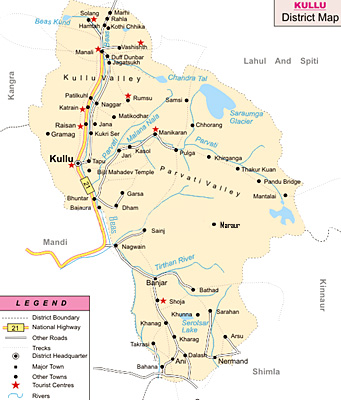 Kullu District is one of the 12 administrative districts of Himachal Pradesh with its headquarters at Kullu town. District headquarter is situated at an altitude of 1200 metres. Average altitude of Kullu District is 1219 metres above the sea level. With a total area of 5503 square kilometre, Kullu was recognised as a district in the year 1963.
Kullu District is one of the 12 administrative districts of Himachal Pradesh with its headquarters at Kullu town. District headquarter is situated at an altitude of 1200 metres. Average altitude of Kullu District is 1219 metres above the sea level. With a total area of 5503 square kilometre, Kullu was recognised as a district in the year 1963.
Location of Kullu District
Kullu District is located at 31 degree 20 minutes 25 seconds to 32 degree 25 minutes north latitude and 76 degree 56 minutes 30 seconds to 77 degree 52 minutes and 20 seconds east longitude. This district of Himachal Pradesh is bounded on the north and east by Lahaul and Spiti District. On the south-east, it is bounded by Kinnaur District. Kullu District is bounded by Shimla district on the south. Further, on the south-west and west it is bounded by Mandi district and, on the north-west by Kangra District.
History of Kullu District
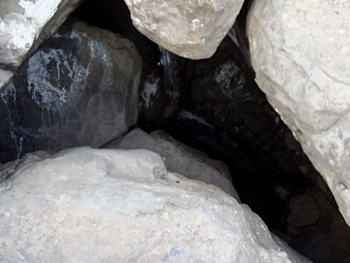 As per the history of Kullu District, references of its origin could be traced back Ramayana and Mahabharata. The valley has witnessed a number of events and incidents believed to be associated with it during Ramayana and Mahabharata period. It is said that Pandavas it is said, visited this valley several times. According to one legend, Arjuna, under the advice of Rishi Vyas, practiced austerities in a cave called `Arjun Gupha` in the mountain of Inderkila (now called Deo Tiba) in order to get the powerful Pasupata Astra from Indra. Vyas Rishi performed his `tapa` in this valley during that period, at a place called `Vyas Kund` on Rohtang Pass. It was because of this that the river Vipasha got the present name of Beas River.
As per the history of Kullu District, references of its origin could be traced back Ramayana and Mahabharata. The valley has witnessed a number of events and incidents believed to be associated with it during Ramayana and Mahabharata period. It is said that Pandavas it is said, visited this valley several times. According to one legend, Arjuna, under the advice of Rishi Vyas, practiced austerities in a cave called `Arjun Gupha` in the mountain of Inderkila (now called Deo Tiba) in order to get the powerful Pasupata Astra from Indra. Vyas Rishi performed his `tapa` in this valley during that period, at a place called `Vyas Kund` on Rohtang Pass. It was because of this that the river Vipasha got the present name of Beas River.
History of Kullu District also suggests the origin of its name. It says that Kullu derives its name from `Kalut` which was a tribe in the upper valley of River Beas, as mentioned by Barahmir in Barihat Sahinta. There are other evidences in history and literature that confirm that the name of this part was `Kalut` and the letter `T` was eventually dropped from the name with the passage of time. Thus, this place got its present name Kullu.
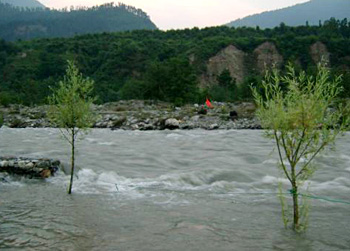 Further, history of Kullu District comprises two phases - pre independence and post independence period. History of the district of the pre-independence period states that Kullu was probably the most ancient state next to Kashmir and Kangra. According to historical accounts, it was founded in the first century of Christian era by Behangamani Pal. Many legends are associated with the name of Behangamani Pal. It appears that the people of the higher valley of Kullu at that time were suffering under the repressive regime of the Thankurs of Spiti. Behangamani Pal organised the upper valley first revolution sparked off at Jagatsukh. Subsequently, Pal dynasty was thus established. Its original capital was established at Jagatsukh and nearly ten generations ruled from there, till it was shifted to Naggar which remained as the seat of the Government for many as 1400 years till it was finally moved to Kullu.
Further, history of Kullu District comprises two phases - pre independence and post independence period. History of the district of the pre-independence period states that Kullu was probably the most ancient state next to Kashmir and Kangra. According to historical accounts, it was founded in the first century of Christian era by Behangamani Pal. Many legends are associated with the name of Behangamani Pal. It appears that the people of the higher valley of Kullu at that time were suffering under the repressive regime of the Thankurs of Spiti. Behangamani Pal organised the upper valley first revolution sparked off at Jagatsukh. Subsequently, Pal dynasty was thus established. Its original capital was established at Jagatsukh and nearly ten generations ruled from there, till it was shifted to Naggar which remained as the seat of the Government for many as 1400 years till it was finally moved to Kullu.
Their rule continued till about 1,450 when reference is available of Raja Kelas Pal. After this, there was long break of about 50 years. It appears the Thakurs and the Ranas might have captured power during this period, forcing the Pal Rajas to flee from the valley. It was again in the fifteenth century that the name of the Sidh Singh appears as the Raja of Kullu. He too helped the people in organizing rallies against the Thakurs and established the old Pal dynasty. Reference may be made to Raja Jagat Singh (1637-1672) who conquered the fort the Madankot which belonged to Jihna Rana, above Manali. It was during his regime that the famous idol of Raghunathji was brought from Ayodhya and installed at the temple of Raghunathji at Sultanpur (Kullu).
History of Kullu District says that after the independence of the country, like other hill states, Kullu had its ups and downs till it was ceded to the British in 1846 as per Lahore agreement, along with other trans-Sutlej states. Firstly, Kullu was made a sub-division of the district of Kangra. Lahul-Spiti was made a part of Kullu for proper administration. In the year 1960, Lahul-Spiti was declared a separate district. In the year 1963, Kullu was also made a separate district and it remained a part of Punjab till October 1966. After the reorganization of states, Kullu District was made a part of Himachal Pradesh on 1st of November, 1966.
Geography of Kullu District
Generally, the climate of Kullu District is cold and dry and the year can be divided into three seasons mainly summer season from March to June, rainy season from July to September and winter season from October to February. From December to February, this period is very chilly. Heavy frost occurs during this period. Snowfall generally occurs during December and January or an early snowfall may occur in November also. During this period, most of the parts of Kullu remain under cover of snow. The average rain fall is 80 cm. Maximum mean temperature recorded in this district is around 38 degree Celsius and minimum temperature is around 5 degree Celsius in winter.
Demography of Kullu District
According to 2001 census, Kullu district has a total population of 3, 81,571. The rural population is estimated to be 3, 51,478. On the other hand, the urban population is 30,093. Further, the literacy rate of Kullu District is 72.90 percent. There are a number of primary, middle and high schools scattered throughout the district. The district has around two colleges. The male literacy rate in the district is around 83.98 percent while the female literacy rate is 60.88 percent.
Temples of Kullu District
Temples of Kullu District are known for their distinct wonderful architecture. Devotees from all parts of the country come to Kullu District and visit its various temples. Thus, it can be said that this place is of great attraction for the religious people as well as for climbers. Some of the popular temples of Kullu District are given below -
Raghunath Temple: The chief deity of Kullu is Raghunath Ji. Raghunath Temple was constructed in 1660 AD with a mixed look of Pahari and Pyramidal style. Everyday puja is held for five times. Round the year, near about 45 festivals are held. Several legends are associated with this temple.
Vaishno Devi Temple: On the way to Manali 3 km from Kullu, Vaishno Devi Temple is a very popular pilgrimage centre of the country. In 1964 AD, a saint established this temple. There is another temple dedicated to Lord Shiva. Beas River flows in front of the temple giving it a spectacular view.
Bijli Mahadev Temple: Situated at an altitude of 2435 metres around 11 kms from Kullu, this temple is ideally located offering a commanding view. Bijli Mahadev Temple is in `khash` style.
Adi Brahma Temple: The temple of Adi Brahma Temple is in Pagoda style. Built in 14th century, it has four roofs. There are three other small temples within the temple premises. The door of the temple has nice carving of Puranic scenes. As temple is situated at a certain height, it provides an excellent view of the nature.
Bishweshwer Temple (Bajuara): Built is 9th century, it was rebuilt in 1673 AD by Raja Shyam Sen of Mandi; this temple is of great architectural value. The style of this temple is pyramidal and is built on Shankaracharya `Panch Dev Puja Padhati` that means worship of five gods together at a place. Along with Shivlinga inside the temple, there are four other gods installed inside the temple - Lord Vishnu, Lord Ganesha and Goddess Durga in the west, south and northern sides respectively whereas Surya is on the top of the temple. The main door opens in the east. The art and sculpture of the temple is beautiful and that is why it has been declared as a protected monument. The walls of this temple are so thick that this temple survived the earthquake of 1905.
Rama Temple (Manikaran-Manali): Rama temple built by Raja Jagat Singh in the place of two Shiva temples is in pyramidal style. The idol of Lord Rama was brought from Ayodhya. The idol was kept here till 1661 AD; thereafter it was shifted to Kullu. The temple was repaired by Raja Dilip Singh in 1889 AD. Since 1981, a trust is looking after the temple. The other temples at Manikaran are Bhagwati temple, Krishna temple and Vishnu temple also known as Raghunath temple.
Dhungri or Hadimba Temple: This temple constructed in pagoda style displays the finest example of wood carving on it. The temple was built by Raja Bahadur Singh in 1553 AD. It is one of the ancient temples of Kullu District.
Manu Maharaj Temple: Manu Temple of Manu Maharaj is located in Manali village, which is about one and half kms from the main town. On the 6th day of Phalguna, the famous Phagli fair is held here in honour of Manu Maharaj, every year. It marks the beginning of the spree of fairs in the valley.
Vashishta Rishi Temple (Manali): There is a 4000 year old temple of Vashishta on the right side of the springs, built by Janamejaya. Inside it, there is a black stone statue of the Rishi Vashishta. Village Vashishta is famous for hot water springs. There is Rama temple on the left side of the spring. Dussehra festival is held here every year for seven days.
Sandhya Devi Temple: Originally this temple was built in vallabhi style architecture and rebuilt by Raja Urdhanpal in 1428 AD according to one inscription. For the third time, it was rebuilt in 19th century. And, now the temple is in pahari style having sloppy roof and square at the bottom. The idol of Lord Ganesha is installed in the temple and is considered a master piece of sculpture.
Dashal Temple: About 30 km from Kullu, on the left bank there is village named Sarsai. Dashal village is near about 1 km from Sarsai village. The temple here is very famous for its architecture. Built in 14th century it is in pyramid style. The temple is built on a raised platform.
Tripura Sundari Temple (Naggar): Tripura Sundari Temple, Naggar is in Pagoda style with three roofs. Raja Yashodhapal built the temple. Sharhi Jatra, a popular fair is held here every year in honor of the goddess in the month of May. The temple consists of stone idols of Lord Ganesh, Lord Vishnu, Lord Brahma, Laxmi Narayan and Shiva-Parvati.
Guari Shankar Temple (Naggar): The temple is in a pyramidal style on a raised platform, with square at the base and a dome above. The stones used are richly engraved. The temple is a protected monument.
Murlidhar Temple (Thawa-Naggar): Thawa is situated at a small distance from Naggar. Murlidhar Temple is in pyramid style, inside it a beautiful idols of Radha-Krishna have been installed. It enjoyed royal patronage for a long time.
Vishnu Temples (Naggar): There are two Vishnu Temples at Naggar. One is on the way to the village on the right side of the road. This temple has small pyramid type shape and is of great archeological importance. The other temple is near the castle on the eastern side, a few steps down from the main road towards the village.
Ambika Temple (Banjar): It is believed that the temple was built by Parasurama in the memory of his mother Renuka.
Hidimba Devi Temple, Manali: Nestled within a pictorial cedar forest, the majestic Hidimba Devi Temple dates back to the medieval period.
Jumla Temple, Prini: Devoted to the most authoritative god in Kullu, Jumla Temple is situated in the charming village of Prini.
Sharvali Devi Temple, Manali: Conceived to have been built by the Pandavas, Shravali Devi Temple is situated near another prominent temple.
Jagatsukh Shiva Temple, Manali: Jagatsukh Temple is considered as a perfect example of a Shikhara-styled architecture.
Gurudwara Sri Narayan Hari, Dhar Deo Dhank Cave, Gadhan Thekchhokling Gompa are other attractions of Kullu having religious significance. A visit to these temples provides memorable and peaceful moments to the people.
Fairs and Festivals of Kullu District
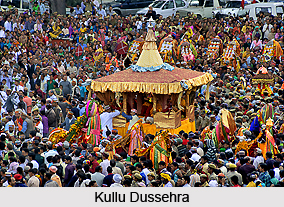 Fairs and festivals of Kullu district are organised by the people on several occasions almost throughout the year. People participate in these fairs and festivals in large numbers. Songs, dances and other cultural programmes are held. Some of these fairs also have commercial importance apart from having religious significance.
Fairs and festivals of Kullu district are organised by the people on several occasions almost throughout the year. People participate in these fairs and festivals in large numbers. Songs, dances and other cultural programmes are held. Some of these fairs also have commercial importance apart from having religious significance.
Kullu Dussehra
Kullu Dussehra is celebrated in the district with great vigour. The week long celebrations take place during Vijya Dashmi. Traditional dances, songs and colourful dresses form some of the enticing aspects of the festival.
Pipal Jatra or Vasantotsava
Vasantotasava is traditionally known as Pipal Jatra. It is celebrated at Dhalpur region of Kullu every year on 16th of Baisakh. In the valley of Kullu, Baisakha is referred to the spring season. The fair is accompanied by traditional music and dances. During this time the people of Lahaul return to their native place after spending the winters in the valley. On their return they buy agricultural and other equipments from the fair. Thus the fair is economically important too.
Shamshi Virshu
This fair marks the beginning of Baisakh. It is organized in a village named Khokhan. This seasonal as well as regional fair is accompanied by the worship of their local deity outside the temple. Yellow sheets of barley along with garlands are offered to the Goddess with the sacrifice of a goat. Exquisite traditional dance is performed by the women around the idol of the deity.
Mela Bhuntar
This fair is organized in the Ashad month of Hindi calendar (June-July). The three day fair is held in the month of Bhunter village. The fair marks the beginning of the utilization of newly harvested crops for cooking. The first cooked food is offered to the deity and is then distributed among the friends and relatives.
Sainj Fair
Sainj Fair is held in the month of April-May. Religious myths are associated with this fair. During this fair, the image of Devta Laxminarayana is brought to Sainj from Raila. Folk dances and rhythmical songs are performed on the beats of trumpet and drums.
Luhri Lavi
It is another fair in the district celebrated in the months of October-November. This two days fair is dedicated to the deities Khegro Maya and Devta Jogeshwar. Worshipping of the deities is accompanied by fold dance, mimicking and Nati dances.
Ani Fair
Ani Fair is held during April-May in Franali village. In the fair, a number of deities belonging to adjacent villages are worshipped. Enchanting cultural functions and folk dances are the attractive features of this fair.
Dalash Fair
In the village of Soidhar, Dalash fair is celebrated in the honour of Devta Jogeshwar Mahadev and Bungli Nag. Cultural programs in this fair comprise of folk dances, songs and sports tournaments.
Dhoongri Fair
Dhoongri Fair is organized in the months of May-June in the honour of Devi Hadimba. Myths say that Devi Hadimba, the wife of one of the Pandavas, Bhima, used to meditate at Dhoogri. The Goddess is worshipped in the fair with great religious fervour.
Sharhi Jatra
Sharhi Jatra is another grand fair organized in the temple of Tripura Sundari situated on a ground called Sharhi. The three day fair, held in May-June, witnesses a large gathering.
Other Fairs and Festivals of Kullu District
In addition to these, other fairs and festivals of the district include Ganter fair, Ghatasani fair, Bhadoli fair, Buddhi Diwali, Phagli fair and Birshu fair.
Tourism in Kullu District
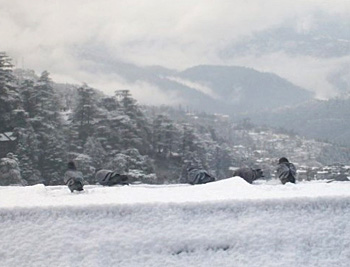 Tourism in Kullu District offers plenty of sightseeing options. Kullu District offers many attractions to the tourists. It has rich art and cultural heritage, lush green deep meadows, dazzling rivers, white capped snowy peaks and high mountains. The district has incomparable Beas River and its sub-valleys which are full of natural charm and grandeur. Though, Kullu does not have the rich historical archaeological or epigraphically antiquities like Chamba but still has some ancient remains antiquities like Nirmand and Hat at Bajaura. Not only the district is famous for its scenic beauty but also as a paradise for the trekkers and mountaineers. Major places of tourist interest in Kullu District are as follows -
Tourism in Kullu District offers plenty of sightseeing options. Kullu District offers many attractions to the tourists. It has rich art and cultural heritage, lush green deep meadows, dazzling rivers, white capped snowy peaks and high mountains. The district has incomparable Beas River and its sub-valleys which are full of natural charm and grandeur. Though, Kullu does not have the rich historical archaeological or epigraphically antiquities like Chamba but still has some ancient remains antiquities like Nirmand and Hat at Bajaura. Not only the district is famous for its scenic beauty but also as a paradise for the trekkers and mountaineers. Major places of tourist interest in Kullu District are as follows -
Kullu: Kullu town has made its name on the international tourist map for its famous Dussehra festival.
Manali: Situated near the end of valley, Manali is one of the most attractive tourist spots of Kullu District. Manali is described with beautiful streams and birdsongs, forests and orchards and amazing snow-capped mountains. Manali is the real starting point of an ancient trade route which crosses the Rohtang and Baralacha passes, and runs via Lahul and Ladakh to Kashmir while divergent road connects it with Spiti. There is an interesting legend about Manali which goes to say that Manu, the author of `Manu Samhita`, established his abode here. The temple dedicated to Manu still exists in Manali village.
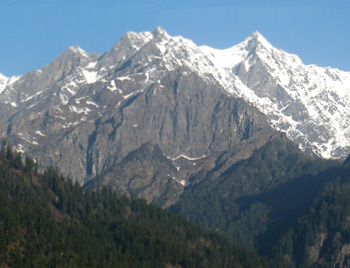 Naggar: Naggar, on the left bank of Beas River and about 300 metres above the river, is delightfully situated on a wooden slope and commands extensive views, especially of the north and west of the valley. It is 27 kms from Kullu. There is a bridge across the Beas River connecting Naggar and Patli Kulh. Naggar was founded by Visudh Pal and continued as the headquarters of the state until the capital was transferred to Kullu (Sultanpur) by Raja Jagat Singh. A massive castle belonging to the Rajas of Kullu still exists here. There is a temple of Lord Shiva, which is considered as a charming example of the architecture and carving. It is presumed that the temple which is a protected monument is eight hundred years old. Further, there are several other temples dedicated to Lord Vishnu, Lord Krishna and Pagoda shaped temple of Tripura Sundri Devi.
Naggar: Naggar, on the left bank of Beas River and about 300 metres above the river, is delightfully situated on a wooden slope and commands extensive views, especially of the north and west of the valley. It is 27 kms from Kullu. There is a bridge across the Beas River connecting Naggar and Patli Kulh. Naggar was founded by Visudh Pal and continued as the headquarters of the state until the capital was transferred to Kullu (Sultanpur) by Raja Jagat Singh. A massive castle belonging to the Rajas of Kullu still exists here. There is a temple of Lord Shiva, which is considered as a charming example of the architecture and carving. It is presumed that the temple which is a protected monument is eight hundred years old. Further, there are several other temples dedicated to Lord Vishnu, Lord Krishna and Pagoda shaped temple of Tripura Sundri Devi.
Rohtang Pass: Numerous mountain passes lead in and out of Kullu, but one of the most popular with trekking facilities is the Rohtang Pass, about 3,978 metres above sea level. It is easily the most convenient route from Manali and throughout the whole distance provides a charming view of the nature. The length of the pass is about 1 km and has served as the route for many centuries for trade with Lahul, Ladakh and to far away countries in Central Asia. To the left of Rohtang Pass there is the little lake of `Sar Kund` that is also called as Dashair.
Jagatsukh: It lies on the left bank of the Beas and the road from Naggar to Manali runs through the village. It is about twelve km from Naggar and six km from Manali. In Jagatsukh some ancient temples are still in existence. The most important being the Jagatsukh Shiva Temple. It has a very chaste sculptured decoration. The temple of Gayatri Devi is also located near this temple.
 Arjun Gufa: This cave is located at around five kms from Manali. According to a legend, Arjuna under the advice of a Vyasa rishi practiced austerities in a cave in order to get the powerful `Pashupata Astra` from Indra.
Arjun Gufa: This cave is located at around five kms from Manali. According to a legend, Arjuna under the advice of a Vyasa rishi practiced austerities in a cave in order to get the powerful `Pashupata Astra` from Indra.
Nehru Kund: It is a spring of clear cold water and is about 6 kms from Manali on Manali-Keylong road.
Solang Valley: It is a splendid valley between Manali and Kothi and offers the views of glaciers and snow caped mountains and peaks. The nearest glacier from Manali is in this valley. It is about 13 kms from Manali.
Manikaran: Nestling among, sylvan surrounding in Parbati valley, Manikaran is famous for its hot springs. Manikaran, at an altitude of 1,829 metres and 40 kms from Kullu, has the finest hot water springs. According to an ancient legend, Manikaran is also connected with Lord Shiva and his divine consort Parvati.
Gurudwara Shri Narayan Hari (Manikaran): Saint Shri Narayan Hari came to Kullu in 1940 from his native place Kamalpur (Pakistan) and settled in Manikaran. Initially there was nothing except two hot water springs in this place. He worked on the Gurudwara building and the 50 years long service bore fruit in the shape of present Gurudwara. There is an artificial cave near the Gurudwara built by the saint where he used to meditate for 40 days or so in a year.
Dhar Deo Dhank Cave: This cave is 3 km from Nirmand towards south. The cave is quite deep and about 6 feet in height. There is a Shivalinga inside the cave. Local people consider it as a very sacred place.
These places are worth visiting and they offer an enriching and tranquil tourism experience to the visitors.
Adventure Tourism in Kullu District
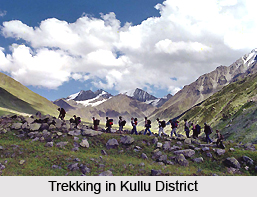 Adventure tourism in Kullu district allures a number of tourists from all over the country. The hilly terrain, gushing rivers and pearly snow in the district forms an ideal place to conduct various adventurous sports. The spectacular landscape of the district, adorned with vibrant greenery, further adds to the charm of the adventure tourism in Kullu district. A number of institutes have also been established in the district that provides various trainings and guides the tourists in different adventurous activities.
Adventure tourism in Kullu district allures a number of tourists from all over the country. The hilly terrain, gushing rivers and pearly snow in the district forms an ideal place to conduct various adventurous sports. The spectacular landscape of the district, adorned with vibrant greenery, further adds to the charm of the adventure tourism in Kullu district. A number of institutes have also been established in the district that provides various trainings and guides the tourists in different adventurous activities.
Mountaineering in Kullu District
Kullu district is a highly hilly region and mountaineering is a popular activity here. To promote this activity, the Western Himalayan Mountaineering Institute (WHMI) has been established at Chadhiari in the year 1961, near the near the hot springs of Vashist Village. The institute was later shifted to its own complex in 1976 at Aleo Bihal, Manali and is called as the Department of Mountaineering and Allied Sports. The institute provides training in snow skiing, high altitude trek and rock climbing. Training in the fields of mountaineering and rescue are also imparted to the tribal folks of this region. The institute also provides equipments and articles to the trekkers.
 Angling
Angling
Beas River along with its tributaries namely Sainj, Parvati, Mani Karan, Katrain and Trithan are rich in trout fishes and thus is a blissful place for tourists interested in angling. Brown trout fish is found abundantly in Tirthan River where fishes are bred. Angling tournament is also organized every year in Kullu District by the Department of Fisheries.
Trekking
Trekking is another much loved tourist activity in Kullu district. Some of the most adventurous yet easy trekking paths are found in this district. Trekking along the resplendent valleys with dense forest, mossy meadows and sparkling streams makes a delightful experience. The best times for trekking in this region are April to mid June and mid September to mid October. Equipments, transportations, porters, meals and medical facilities are provided to the trekkers by different institutes situated here.
White Water Rafting
Another thrilling adventure sport of Kullu district is white water rafting. A long downstream path from Badah to Jhiri offers an enchanting experience to the rafters. Rafting is allowed only in summers, from the month of May to July. Essential equipments and gears are provided to rafters by various professional companies. Life jackets and helmets are the most significant requirements of rafting. Special dresses are worn during rafting and guides are available to guide the tourists throughout the white water rafting.

Skiing
Skiing, done especially during winters, invites a number of adventure loving tourists to Kullu district. The thick layer of snow over the mountains provides an exquisite experience to the skiers. Training for skiing is provided to the tourists by the Mountaineering Institute, Manali. Skiing courses are also conducted by the institutes whereas skiing tournaments at national as well as international level are another delightful watch. Bhrigu peaks in the district forms one of the best slopes of the world. Solang organizes winter skiing whereas Rohtang slopes organizes summer skiing.
Heli-Skiing
Heli-Skiing is a new adventure sport conducted in Manali of Kullu district. In this sport, the skiers are dropped from helicopters, at high altitudes, on the mountains. Usually a group of three skiers, well equipped with safety tools, are involved in this sport. Heli Skiing is practiced especially in winters as it requires enough snow.
Paragliding
Para Gliding is another popular adventure sport practiced extensively in Kullu district. This thrilling adventure is done in hills and the ideal locations include Bhaikhali, Slang and Bijli Mahadev slopes. May-June and September-October are the best times for Para Gliding. Training courses of seven days are also provided here for guiding the tourists.



















